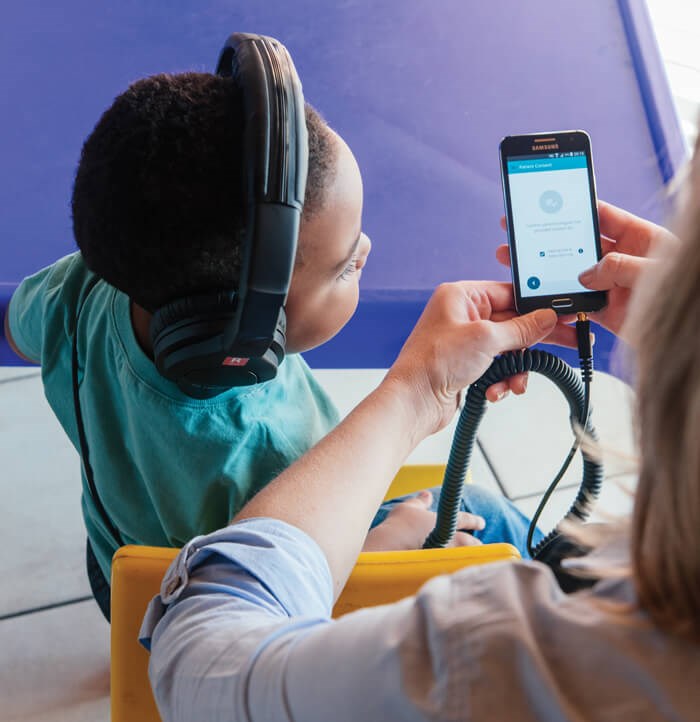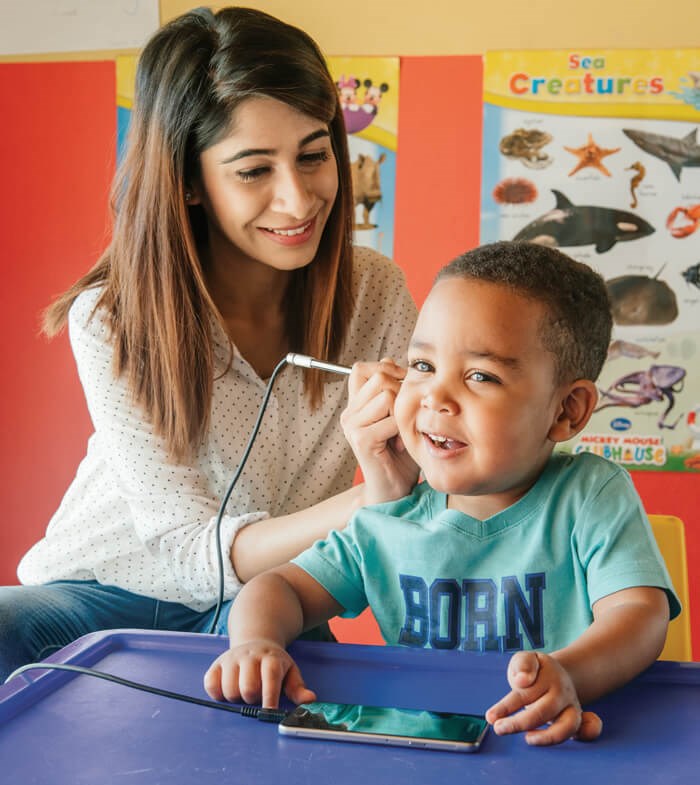By combining mobile technology with artificial intelligence, more people can access ear and hearing care.
The World Health Organization (WHO) estimates that worldwide, nearly half a billion people have moderate or worse hearing loss [1]. The vast majority of people affected live in low and middle-income countries (LMICs) where there is a dearth of human and technical resources to screen, diagnose, treat and rehabilitate. In recent years, there has been a proliferation of smartphone apps for ear and hearing care.
These mobile tools have already been used for a wide range of applications, including school screening, screening hearing in population-based surveys, and self-testing hearing. This article will describe how technology is able to bridge the gap, and support the unmet need for ear and hearing care, particularly in underserved communities.
Applications of mobile tech in LMICs
The ubiquitous nature of mobile technologies and connectivity in LMICs make them uniquely suited for widespread use to identify ear and hearing problems early on. Intuitive user-interfaces, human-centred design approaches and the use of automated test protocols are making it possible for lay or community health workers to provide screening services [2].

Figure 1. hearScreen performed on a child.
A recent study in a low-income community demonstrates how lay health workers can provide combined hearing and vision screening for preschool children using mobile technologies in a cost-effective manner (Figure 1) [2]. Other advantages of these technologies include quality control features, like monitoring environmental noise for reliable testing and integration with cloud-based data management for surveillance, reporting and referrals.
“The portability and low-cost nature of mobile tools make them highly suitable for use in population-based surveys to measure the prevalence and causes of hearing loss”
The portability and low-cost nature of mobile tools make them highly suitable for use in population-based surveys to measure the prevalence and causes of hearing loss. This is particularly important in the context of very limited population-based data on hearing loss in LMICs, making it difficult to plan appropriate services. The Rapid Assessment of Hearing Loss (RAHL) survey protocol, recently developed by researchers at the London School of Hygiene & Tropical Medicine, utilises a validated tool hearTestTM (hearX, SA) to assess thresholds of participants [3]. The RAHL methodology focuses on people aged 50+ based on evidence that >70% of hearing loss is experienced by this age group, and the causes in this age group are representative of the all-age population [4]. This substantially reduces the costs of undertaking population-based surveys, by reducing the sample size, range of clinical tools needed to assess hearing and establish the causes, and the level of specialist experience of data collectors needed.
“Mobile technologies are also starting to offer ways to accurately diagnose ear disease with advanced artificial intelligence approaches”
Evidence from Malawi has found that non-specialist health workers (e.g., community health workers) can accurately assess hearing using hearTest [5]. In RAHL, hearing assessment with hearTest occurs in the participant’s household in a quiet location. Experience from surveys in Malawi, China, The Gambia and Chile, has found the use of mobile tools to be well accepted by participants; they are easy to use and encounter limited problems with background noise.
Mobile technologies are also starting to offer ways to accurately diagnose ear disease with advanced artificial intelligence (AI) approaches. Whilst the majority of adult hearing losses are sensorineural, children and many adults in LMICs may also present with conductive or mixed losses due to ear disease. The number of qualified and experienced healthcare professionals to diagnose and treat ear disease appropriately is severely limited in regions like Sub-Saharan Africa. Smartphone-based video-otoscopy using devices like the hearScopeTM (hearX, SA) makes it affordable to capture images of tympanic membranes in primary care settings and can enable remote diagnoses using telemedicine (Figure 2).

Figure 2. hearScope performed on a child.
Recently however, the first AI tympanic membrane image classification system has been released and is in beta testing mode for all users of the hearScopeTM App. This feature uses a validated AI approach to accurately classify captured images, almost in real time, to assist in the diagnosis of ear disease (see video showing hearScope AI classification examples). These types of technologies have the potential to allow accurate specialised diagnosis in primary care settings for early treatment as a preventative strategy.
Limitations with technology
Despite the opportunities that mobile technology present in overcoming barriers to accessing care, there are some challenges. Mobile technology is not a silver bullet, and will not address the vital need for increasing the health workforce for ear and hearing care in LMICs. They could form part of a range of interventions to strengthen service delivery and, in particular, reach rural and remote communities. Moreover, some available apps have not been validated, and thus caution on the choice of tool is required [6]. Although mobile tools for ear and hearing care may be lower cost than currently available screening methods, they may have a shorter lifespan; for instance, when operating systems no longer support the use of the app or device. Battery life of mobile technology (tablets and phones), is also limited, and degenerates over the lifespan of the device. Also, calibration of devices used for hearing testing should be considered. Other concerns include data security and reporting formats using mobile technology platforms, which should be carefully scrutinised during service development and implementation [7].
Further research/developments
Mobile apps and technologies are clearly demonstrating their potential to support accessibility and affordability in decentralised detection and diagnosis of hearing loss in children and adults [7]. Other areas of development that would support early detection in infants are smartphone-operated versions of otoacoustic emission testing which could reduce costs and finally enable widespread screening in LMICs [7].
“Programming affordable hearing aids after a smartphone hearing test directly from the phone is another way in which hearing aids could be provided by minimally trained persons”
Considering the continuum of hearing care, an urgent area of future research concerns delivery of treatment options using mobile technologies. The use of smartphones as assistive listening and amplification devices demonstrates potential, although initial results suggest significant development and validation work is still required. These options are also likely to cater for persons with milder degrees of hearing loss. Programming affordable hearing aids after a smartphone hearing test directly from the phone is another way in which hearing aids could be provided by minimally trained persons. Apps that accompany these solutions can enable patients to control their devices and link up with resources and professionals as rehabilitation support.
Conclusion
Mobile technology for ear and hearing care is rapidly growing and changing. There is ample evidence to suggest these tools are an important part of a range of interventions needed to support access to ear and hearing care in LMICs. From school screening by non-specialist health workers, to diagnosis of middle ear conditions using AI, this article has highlighted some of the potential applications. Before choosing a tool, it is important to consider whether the tool has been validated, equipment maintenance, and patient data security.
References
1. World Health Organization. Addressing the rising prevalence of hearing loss. 2018.
https://apps.who.int/iris/bitstream/handle/
10665/260336/9789241550260
-eng.pdf?sequence=1&ua=1
Last accessed April 2021.
2. Eksteen S, Launer S, Kuper H, et al. Hearing and vision screening for preschool children using mobile technology, South Africa. Bulletin of the World Health Organization 2019;97:672-80.
3. van Tonder J, Swanepoel D, Mahomed-Asmail F, et al. Automated Smartphone Threshold Audiometry: Validity and Time Efficiency. J Am Acad Audiol 2017;28(3):200-8.
4. Bright T, Mactaggart I, Kim M, et al. Rationale for a Rapid Methodology to Assess the Prevalence of Hearing Loss in Population-Based Surveys. International Journal of Environmental Research and Public Health 2019;16(18):3405
5. Bright T, Mulwafu W, Phir M, et al. Diagnostic accuracy of non-specialist versus specialist health workers in diagnosing hearing loss and ear disease in Malawi. Tropical Medicine and International Health 2019;24(7):817-28.
6. Bright T, Pallawela D. Validated Smartphone-Based Apps for Ear and Hearing Assessments: A Review. JMIR Rehabil Assist Technol 2016;3(2):e13.
7. Swanepoel D, Smits C, De Sousa KC, Moore D. Mobile apps to screen for hearing loss: Opportunities and challenges. Bulletin of the World Health Organization 2019;97(10):717-8.
For more on this topic, see Differing outcomes of three Sub Saharan Africa journeys with the common goal of task sharing in audiology by Jackie Clark, Karin Joubert, Alfred Mwamba






